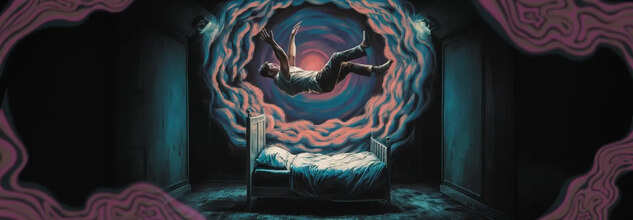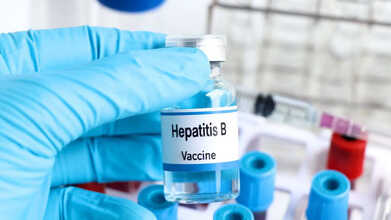- Health Conditions A-Z
- Health & Wellness
- Nutrition
- Fitness
- Health News
- Ayurveda
- Videos
- Medicine A-Z
- Parenting
Why Do I Feel A Falling Sensation In Sleep?

Have you ever been so tired that the moment you hit the bed, you feel like you are sinking in your mattress? Or did you ever feel your leg twitch in middle of your sleep? Did you feel like you moved your leg to prevent yourself from falling down? If yes, then you are in for a great read!
Why does this happen?
You are not alone, this happens to around 70% of the total population in some way or another. Although these are signs of sleep disorders, it can also happen to people who are otherwise healthy. Sleep disorder specialists believe that there are certain common triggers that leads to such a sensation.
Our brain is exceptional and sometimes when we dream, it makes us believe that we our part of the dream. And if you are falling from somewhere in your dream, chances are, you would feel like you are falling in real life. This experience is known as hypnic jerk, the movement of your muscle that helps you be safe from that fall, or the imaginary one.
What causes it? When we sleep, our bodies become paralyzed, but that does not mean that our muscle control is not totally off. Rather, a slow, dimmer switch. When the dim switch randomly is turned on, we get jerky movements in our sleep.
This involuntary muscle movement is also called myoclonus or hypnic myoclonus, that transitions as you shift from one sleep phase into another.
ALSO SEE: What is sleep paralysis?
What Could Cause It?
There are many theories on what might be causing it. One of them is that when you are at this stage of sleep, you are still not in deep sleep and your brain misinterprets it as wakefulness, however, at the same time your brain does not recognize your muscles to be moving. This is what leads your brain to send a message to your muscles to check-in. It is a way your brain tries to protect you.
Another theory is of course that of stress. When you are stressed, your mind might be racing, while your body is in stationary. This can also affect your sleep cycle and your sleep can be disrupted.
If you are on stimulant drugs or alcohol, it too can prevent you from achieving a good night sleep. If you have consumed too much caffeine then too your muscles can twitch to make you stay awake.
Furthermore, lack of sleep could also be the reason why your mind is used to staying awake even if your body really needs the rest.
Periodic Limb Movement Disorder
While the falling sensation in sleep is quite common, and happens to healthy people, a severe form is the Periodic Limb Movement Disorder (PLMD). PLMD is a repetitive cramping or jerking of legs during sleep. It is a movement disorder that happens only during sleep. It is called "periodic" because the movements are repetitive and rhythmic, which means it occurs in every 20 to 40 seconds. It is also often linked with restless legs syndrome, however, the two are not the same thing.
Restless leg syndrome on the other hand is a condition that involves strange sensations in the legs and arms while awake and an irresistible urge to move the limbs to relive the sensations.
What causes PLMD may be more severe things, including diabetes, iron deficiency, spinal cord tumor, spinal cord injury, sleep apnea, uremia, anemia, narcolepsy, or certain medications.
Hepatitis B Infection And Vaccination: Risks, Safety, And Long-Term Protection

Credits: Canva
A federal vaccine advisory group in the United States is preparing to decide whether newborns should continue to receive the hepatitis B vaccine, which was the first shot proven to prevent cancer. The CDC committee is expected to revisit the long-standing guidance from the early 1990s, when the vaccine began to be given within the first 24 hours of life.
As per CNN, advisers to the Centers for Disease Control and Prevention will be voting on Friday to vote on whether the agency should move away from its long-held recommendation that every infant receive the hepatitis B shot shortly after birth. The information below outlines key points everyone should understand about hepatitis B and its vaccine.
What is Hepatitis B?
Hepatitis B is a viral infection that affects the liver. Many adults are able to clear the virus after an acute infection. Some, however, go on to develop chronic hepatitis B, which increases the risk of liver cancer, liver failure and cirrhosis, or permanent scarring of the liver.
People who live with chronic hepatitis B face a much higher chance of dying early. At the ACIP meeting on Thursday, Dr. Sandra Fryhofer, who spoke on behalf of the American Medical Association, described her experience working on a hepatitis B ward during medical school, according to CNN.
She said that those were the sickest patients she had ever encountered. She explained that she has treated people with liver disease caused by hepatitis B, cirrhosis linked to the virus, and liver cancer, as well as deaths related to the infection. Infants and young children who contract hepatitis B are far more likely to develop lifelong disease, including about 90 percent of infected babies and roughly 30 percent of children between one and five years of age.
How Is Hepatitis B Spread?
The hepatitis B virus is highly contagious. It spreads when blood, semen or other bodily fluids from a person who carries the virus enter the body of someone who is not infected.
Certain medical conditions, personal habits and other circumstances can raise the risk, such as injection drug use or sexual contact, but the virus can infect anyone. Hepatitis B can also pass from an infected mother to her baby during childbirth, whether through a vaginal delivery or a C section.
How Common Is Hepatitis B?
Many people living with hepatitis B show no clear symptoms, and more than half may not know they are infected. Recent CDC figures report about 2200 newly documented cases of acute hepatitis B in 2023, although the true number is estimated to be more than six times higher, closer to 14400.
The CDC also estimates that about 640000 adults in the United States have chronic hepatitis B. Worldwide, the World Health Organization reports that 254 million people are living with chronic hepatitis B, with about 1.2 million new infections each year.
Can Hepatitis B Be Treated?
There is no treatment for acute hepatitis B. Some medicines are available for chronic infection. These treatments may need to be taken for life because there is no cure.
How Can Hepatitis B Be Prevented?
Vaccination is the most reliable way to prevent hepatitis B. The shots offer strong protection in infancy and continue to shield individuals well into adulthood.
Most people who live with hepatitis B contracted it as babies or very young children, when their immune systems were not fully developed, according to the CDC. At present, the agency recommends that all infants receive the vaccine at birth before leaving the hospital.
Babies usually receive a three dose series. A scientific review by the Vaccine Integrity Project found that 95 percent of healthy infants develop enough immunity after the third dose. The vaccine also lowers the risk of infection by nearly 70 percent in babies born to mothers who have hepatitis B.
More than 90 per cent of people who completed the vaccine series showed signs of continued protection 30 years later, based on CDC data.
Is The Hepatitis B Vaccine Safe?
According to the Vaccine Integrity Project’s review, giving the hepatitis B shot at birth has consistently proven safe. Only mild and short-lasting reactions have been noted, such as slight swelling or redness at the injection site and low fever. There was no rise in serious life-threatening reactions linked to the vaccine.
Dr. Anthony Fiore, an infectious diseases specialist and former CDC official who worked in the hepatitis division, described it as a very safe vaccine. He said it has been studied thoroughly before and after approval. He added that the United States vaccine safety systems have looked closely at concerns about fever or other chronic problems.
He explained that none of these concerns have been confirmed. No long-term harm has been linked to the vaccine, and nothing comes close to the danger posed by chronic hepatitis B infection.
Shingles Vaccine Linked To Slower Dementia Progression, Study Finds

Credits: Canva
A shingles vaccination effort launched in Wales in 2013 has produced two findings that bring new optimism to dementia research. The program appears not only to lower the likelihood of mild cognitive impairment but also to slow the course of dementia in people who already have the condition. Shingles stems from the varicella zoster virus and causes a painful rash.
Around one in three people in the United States will experience shingles during their lifetime, with the risk rising sharply with age. For this reason, adults aged fifty and older in the United States are advised to receive two doses of the shingles vaccine.
The vaccine has long been known to prevent shingles with an effectiveness above ninety percent for older adults, but recent work suggests it may hold additional advantages.
What Is Shingles?
Shingles, or herpes zoster, is caused by the varicella zoster virus, which is also responsible for chickenpox. It usually presents as a cluster of blistered skin on one side of the body, often forming a band across the torso. After a person recovers from chickenpox, the virus stays in the nerve cells and can reactivate years later, especially when the immune system weakens, according to Mayo Clinic.
What Is Dementia?
Dementia refers to a collection of symptoms that include significant problems with memory, reasoning, and daily function. It results from damage to brain cells caused by several conditions, including Alzheimer’s disease and vascular dementia. Although dementia becomes more common with age, it is not considered a normal part of growing older, as outlined by the World Health Organization.
Shingles Vaccine Linked To Dementia Progression
Growing evidence indicates that receiving the shingles vaccine may lower the chances of developing dementia. A new study, published Tuesday in the journal Cell, builds on earlier research by proposing that the vaccine might also slow existing dementia, which could reduce the risk of death related to the disease.
“We see a change in the odds of dying from dementia among people who already have the condition,” said Dr. Pascal Geldsetzer, an assistant professor of medicine at Stanford University and senior author of the new study.
“That means the vaccine may not only prevent dementia, but it might also serve as a form of treatment because we notice improvements in people already living with the disease,” he said. “This was both surprising and encouraging.” The new study follows earlier work by Geldsetzer and his team showing that shingles vaccination may help delay or prevent dementia.
In that earlier analysis, researchers reviewed health records from older adults in Wales, where a shingles vaccine program for people in their seventies began on September 1, 2013. Under the rules of the program, individuals who were seventy-nine on that date could receive the vaccine for one year, while those aged eighty or older were not included.
That cutoff allowed researchers to compare outcomes between seventy-nine-year-olds who were offered the vaccine and eighty-year-olds who were not eligible but might have chosen to be vaccinated had they been allowed.
Challenges With The Shingles Vaccine And Reducing Dementia Progression
The next task will be to understand why the shingles vaccine might influence dementia risk or progression. The answer may lie in interactions involving the nervous system or immune response. Certain viruses that affect nerve tissue have been linked in animal studies to the harmful protein accumulation seen in Alzheimer’s disease.
Future research may examine larger and more diverse groups of people, and may also explore how the newer shingles vaccine compares with the older version used in Wales in 2013, which has since been replaced.
“At least directing part of our research efforts toward these pathways might bring important progress in both prevention and treatment,” said biomedical scientist Pascal Geldsetzer from Stanford University.
This Common Heartburn Medicine Causes Bone Loss And Fractures, According To Doctor; Here Are Safer Alternatives

Credits: iStock
Of the many medicines that we consume on a day to day basis, we are not aware of how gradually they are actually making our health worse. One medicine that is common in many households, especially in India households, as points Dr Obaidur Rahman, Ortho and Sports Surgeon is pantoprazole, popularly sold under the name PAN40, PAN Top or PAN D. These medicines are used to treat and relieve symptoms of heartburn, which is a common symptom of acid reflux and GERD.
"A patient came to me, he was an 80-year-old male. He has a habit of taking this tablet regularly, and because of that he suffered an osteoporotic fracture. This means he fell while walking and fractured," points out Dr Rahman.
Also Read: Shingles Vaccine Linked To Slower Dementia Progression, Study Finds
He says that many people, old and young, alike, have a habit of taking this pill like a multivitamin. In fact, they have substituted with pro and prebiotics and assume that it helps with digestion. However, he points out, "If you take this regularly, your gastric mucosa stops responding against proper acid production. And there is also an impairment in digestion."
He says that in clinical practice, it has been found that this common household medicine, which is often procured as over-the-counter or OTC medicine, meaning, without prescription, could cause Vitamin B12 deficiency, and magnesium deficiency.
What Does The Science Say About Pantoprazole Use?
As per a 2023 study published in the journal BioMed Research International, pantoprazole cause bone loss, which could be prevented by adding octreotide.
The study analyzed the serum levels of calcium, phosphorus, and ALP before starting the treatment, and at the end of 12 weeks of treatment on pantoprazole, significant decline in calcium levels were noticed, as compared with other groups. The study also found that octreotide significantly prevented the effect of pantoprazole on the serum levels of calcium and ALP.
The study also found that pantoprazole decreased femoral bone density and femoral BMAD. Besides this, another decrease was found in the femoral bone weight and volume as well as the trabecular volume.
Another study from 2021, published in the European Journal of Clinical Pharmacology pointed out that 12 patients had major fractures and showed changes in serum Mg2+ and Ca2+ levels over a period of 1 month as well as the animal study also showed ionic imbalance over 8-week treatment with pantoprazole. Bone density measured for the patient at the end of the 1-month treatment was found to be in the osteopenic category, together with the animal study which showed a decrease in femur bone strength for the animal treated with pantoprazole over a period of 8 weeks.
Are There Any Safer Alternatives To Pantoprazole?
Pantoprazole contain Proton Pump Inhibitor (PPI), and prokinetic, long-term use of PPIs is associated with the risk of bone fracture. However, alternatives like Histamine H2-receptor antagonists or H2 blockers are effective alternative that do not cause bone loss, notes a 2020 study published in journal Bone, titled Comparative analysis of the risk of osteoporotic fractures with proton pump inhibitor use and histamine-2 receptor antagonist therapy in elderly women: A nationwide population-based nested case-control study.
The safer alternatives are:
Famotidine (Pepcid, Calmicid, Fluxid, Mylanta AR) is a potent H2 blocker used to manage acidity and heartburn. Studies show that famotidine is not thought to raise the risk of osteoporosis.
Other options: Ranitidine (Zantac - where available, as it was withdrawn in some markets due to safety concerns) and Nizatidine are other H2 blockers.
Note: Health & Me do not encourage discontinuance of any prescribed medicine by a doctor. Before making any change in your medicine schedule, please speak to your doctor/GP.
© 2024 Bennett, Coleman & Company Limited

